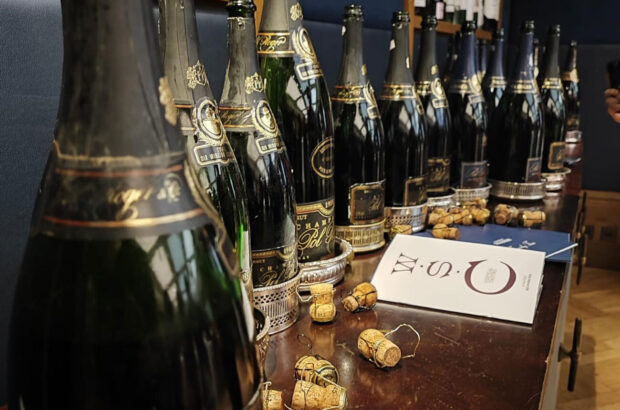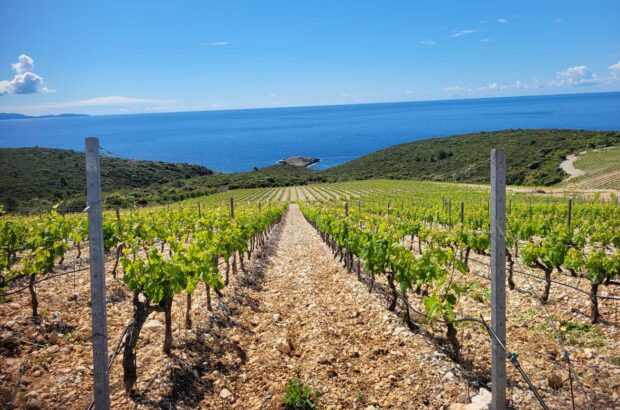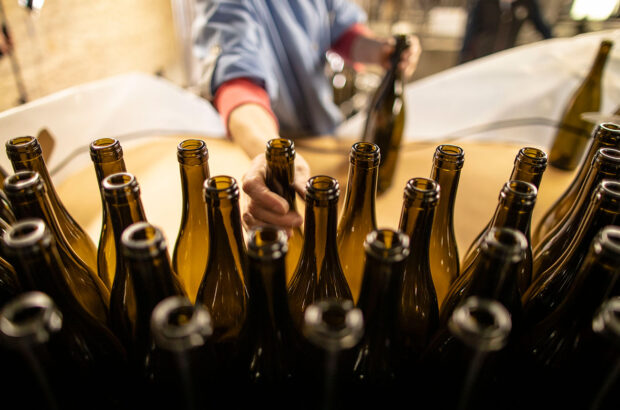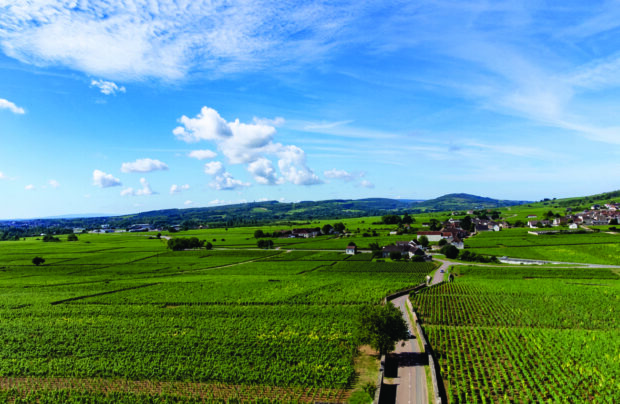- There is now a very real shortage of grapes in the Douro for white port.
- White vineyards are still largely in chaos.
- There is much to write home about when it comes to Portugal’s white wines.
Portugal is often labelled firmly as a ‘red wine country’. This is justified in that port, the Douro, Dão, Bairrada and the Alentejo have all become headline-grabbing reds based on Portugal’s remarkable stockpile of native red grape varieties. But a look at the small print reveals that more than 40% of Portugal’s total wine production is not red but white and that there are some similarly intriguing indigenous white grapes in Portugal’s white wines.
The Portuguese, themselves, are to blame for the neglect of their white wine heritage. Back in the late 19th century, no British wine list would have been complete without Bucelas which at the time was known as ‘Portuguese Hock’. Phylloxera, then fashion, took its toll and growers in the south of the country turned to high-yielding, neutral grape varieties which either provided a base for distillation (and subsequent fortification of port) or large quantities of wine for the undemanding café society. Vinho Verde briefly brought Portuguese white wines back to international prominence in the 1980s, but a combination of bad luck (poor vintages) and bad management quickly undermined its right to a place on the shelves.
When the port shippers began their viticultural sort out in the early 1980s they naturally focused on the red grape varieties that make the finest tawny and vintage ports. White varieties were completely ignored, so much so that 20 years later there is now a very real shortage of grapes in the Douro for white port. Elsewhere in the country (with the notable exception of Vinho Verde) the emphasis has also been on red varietals at the expense of white. Although white winemaking has improved dramatically over the same period with the introduction of stainless steel and temperature control, white vineyards are still largely in chaos. The interplanting (as opposed to batch planting) of different varieties is rife. This means that in regions like Douro, Dão and Estremadura where a large number of different varieties have historically been grown, it is almost impossible to separate one grape from another. The good, the bad and (where rot has set in) the ugly, are all-too-often thrown in the vat together and fingers are crossed as to the final outcome.
But there is still much to write home about when it comes to Portuguese white wines. Where unfettered from the often arcane local laws, enterprising winemakers are gradually identifying the most promising grapes and turning their hand to producing serious white wines. For some in the Douro and Dão it must be like learning to walk again as they endeavour to match virtually unknown grape varieties to untried winemaking techniques. Two producers in particular, Dirk Niepoort and Quinta dos Roques, have already proved that they can not only walk but run ahead with the best.
The following count as Portugal’s most promising (or merely intriguing) white grape varieties and form the basis (alone or in a blend) for the country’s best white wines:
Alvarinho
Potentially one of Portugal’s most thrilling grapes, Alvarinho has been woefully overlooked by both growers and winemakers. For decades it was confined to the area around the towns of Monção and Melgaço in the extreme north where, on a good day, it occasionally challenged the Albariño wines of neighbouring Galicia. The young Anselmo Mendes (responsible for Quinta de Alderiz) has made himself into Monção’s ‘Mr Alvarinho’. And at long last, Alvarinho is breaking into other regions: most recently Estremadura, where the enterprising José Neiva has developed a 50:50 blend of Alvarinho and Chardonnay. With green, floral aromas and a flavour akin to biting into an English Cox apple, Alvarinho deserves far more attention than it’s currently getting.
Best wines: Soalheiro, Vinho Verde; Quinta de Alderiz, Vinho Verde; Grand’ Arte Alvarinho- Chardonnay, Estremadura (DFJ Vinhos).
Antão Vaz
This grape copes admirably with the extreme heat of the Alentejo (‘red wine country’). Early picking (in mid-August) is helping to conserve natural acidity and João Portugal Ramos is now making a crisp, almost ‘cool’ varietal from Antão Vaz. Others garner alcohol and depth by turning Antão Vaz into a vehicle for barrel fermentation and oak-ageing. To compensate for the loss of acidity it is often blended with Arinto or Roupeiro: two grapes which alongside Antão Vaz are becoming the Alentejano trio.
Best wines: João Portugal Ramos Antão Vaz, Alentejano; Esporão Reserva, Alentejo/ Reguengos; Cartuxa, Evora/Reguengos; Marquês de Borba, Alentejano (João Portugal Ramos).
Arinto
Despite the warm climate of southern Portugal, Arinto hangs on to its acidity. It is most at home in the tiny enclave of Bucelas, northeast of Lisbon, but the best examples are coming out of Estremadura. If stretched the wines are merely grassy and acidic but, with lower yields, Arinto is capable of a delightful leafy, lemon and lime character. Arinto is also valued as a bolster to acidity in the wines of Alentejo and Terras do Sado.
Best wines: Quinta D Carlos, Alenquer; JP Arinto, Estremadura (JP Vinhos).
Bical
Potentially Portugal’s answer to Riesling, Bical is unusual among Portuguese white grapes in that it is capable of producing wines that gain in character and depth with age. Planted extensively in Bairrada and Dão, the wines are green and grassy when young but, in the case of Casa de Saima, take on petrol notes with a decade or so in bottle.
In the Dão, the Bical grape is known as Borrado das Moscas (fly droppings) because of its speckled skin.
Best wines: Casa de Saima; Bela Fonte, Bical (DFJ Vinhos).
Chardonnay
The ubiquitous Chardonnay has made remarkably few inroads in Portugal. There are commercial quantities in the Ribatejo (vinified by Peter Bright) and isolated vineyards in the Douro, Beiras, Estremadura and Terras do Sado. Chardonnay brought acclaim to Portugal two years ago when Real Vinicola’s Californian-inspired Quinta de Sidrô won a gold medal an international wine competition. The Chardonnay grape also crops up in a number of successful semi-native blends, most notably José Neiva’s Alvarinho-Chardonnay and with Fernão Pires in Catarina from JP Vinhos.
Best wines: Cova da Ursa, Terras do Sado (JPVinhos); Quinta de Sidrô, Trás-os-Montes (Real Vinicola).
Encruzado
Only recently confirmed as being much the best white grape in Dão, Encruzado is now leading the varietal charge and looks set to become one of Portugal’s favoured varieties. The wines have a flavour akin to apples and pears, with a depth and breadth able to take some new oak. Encruzado wines supposedly age well in bottle but, as yet, are too recent to have a track record. Nonetheless, Quinta dos Roques’ ripe, burgundian-style Encruzado has already been rightly earmarked as one of Portugal’s leading whites.
Best wines: Quinta dos Roques Encruzado; Quinta dos Carvalhais Encruzado (Sogrape)
Esgana Cão
Portugal’s ‘dog strangler’ grape sounds as fierce as it is! This grape is capable of prodigious levels of acidity whereever it is planted. It is, in fact, better known by its off-shore name Sercial but on the mainland as Esgana Cão or Esganoso (plain ‘strangler’) it finds its way into Vinho Verde, Douro wines and Bucelas. While a varietal ‘dog strangler’ might be an interesting marketing ploy, I suspect the wine would win few friends.
Fernão Pires
Often treated as something of a workhorse, Fernão Pires is clearly capable of better.
It is an adaptable variety producing everything from fresh, peppery wines in Bairrada to softer, oak-aged dry whites and even a sweet, botrytised wine in the warmer climes of the Ribatejo. It also blends well with Chardonnay. Strangely the grape undergoes a ‘sex change’ depending on where it is planted – Fernão (‘Ferdinand’) in the south and Maria Gomes in the north.
Best wines: Quinta de Pedralvites, Bairrada (Sogrape); Vale de Rosas, Estremadura (DFJ Vinhos); Catarina, Terras do Sado (JP Vinhos).
Gouveio
Madeira’s Verdelho turns up in the Douro, where it is known as Gouveio. Although
a constituent in many Douro blends, it is surely capable of better than the rather
flaccid wines produced so far. Winemakers might wake up if they were shown the exotic Verdelhos produced in Victoria and Western Australia. The only winemaker more than half-awake is Dirk Niepoort, who has blended Gouveio and Rabigato to make a rich, concentrated Douro white.
Loureiro
Apart from Alvarinho which clearly leads the field, Loureiro is the best grape in the Vinho Verde region (albeit a rather weak runner-up). It was traditionally blended with Trajadura and Paderña (alias Arinto) but is now being used successfully on its own to produce fresh, focused wines resembling dilute Riesling. But be warned: these wines do not develop with age and need drinking when young and fresh. Most varietal Vinhos Verdes are now labelled with a vintage.
Best wines: Quinta de Tamariz, Vinho Verde; Aveleda Loureiro, Vinho Verde
Moscatel
Planted primarily for fortified wines, the Moscatel de Setúbal grape (Muscat of Alexandria) has been diversifying since Peter Bright created João Pires Dry Muscat in the early 1980s. In recent years, the mantle has been taken up by José Maria da Fonseca, who blends Muscat with local grapes, and the well-run cooperative at Pegoes.
Best wine: Vale da Judia, Terras do Sado (Adega Coop Sto Isidro de Pegões).
Rabigato
The ‘cat’s tail’ grape in northern Portugal mutates into the ewe’s tail (Rabo de Ovelha) in the south: thankfully nothing to do with the aromas but rather the shape of the bunch. Rabigato has long been a constituent in white port, and though not yet a varietal, at high altitudes and with lowish yields it is capable of intense yet balanced dry white wines. Niepoort has come closest to proving its worth blending Rabigato with Gouveio to make a Douro white that, when young, bears more than a passing resemblance to good Condrieu. Another good Douro white with Rabigato as a mainstay (plus Fernão Pires, Viosinho and Malvasia Fina) is Vallado.
Best wine: Redoma, Douro (Niepoort)
Roupeiro
When the Alentejo began to produce cool-fermented white wines a decade or so ago, Roupeiro seemed to be the only variety with any character. It is capable of making wines with a fresh, slightly honeyed character but, on its own, Roupeiro lacks staying power. For producers like Cartuxa, Esporão and João Portugal Ramos, Roupeiro is an important constituent in blends but needs to be backed by Antão Vaz and Arinto.
Sauvignon Blanc
Sauvignon crops up in two places in Portugal: the Douro and Ribatejo. Both are surprising given that Sauvignon is thought of as a cool climate grape. In fact João Nicolau de Almeida has planted Sauvignon at high altitudes on the southern margin of the Douro alongside local grape varieties. It adds a distinct grassiness to the weight of the Viosinho and Rabigato.
Best wine: Quinta dos Bons Ares, Trás-os-Montes (Ramos Pinto).
Viosinho
One of the better Douro varieties, Viosinho suffers from a lack of acidity at low altitudes but makes up for it when planted higher up and with low yields. So far this is a grape for blending rather than the varietal approach and makes up a significant part of the better Douro whites from Ramos Pinto, Sogrape and Vallado.












